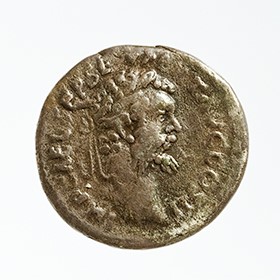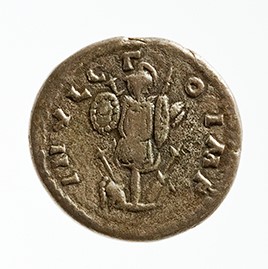Title: Denarius of Septimius Severus - 1986.13
Acquisition number: 1986.13
Author or editor: Beryl Rawson
Culture or period: Roman Imperial
Date: AD 194
Material: Metal - Silver
Object type: Coins - Roman
Dimensions: 18mm (w)
Origin region or location: Syria
Origin city: Emesa
Display case or on loan: 7
Keywords: Coin, denarius, Roman, Imperial, Septimius Severus, Emesa, Roman Syria
Sear, D.R., Roman Coins and their Values 5 vols (London, Spink, 2000-2014) 6288; Mattingly, H., E.A. Sydenham, C.H. Sutherland, R.A. Carson, The Roman Imperial Coinage 13 vols (London, Spink, 1923-1994) IV.1 143 no. 389; Seaby, H.A., Roman Silver Coins (London, B.A. Seaby, 1967) III 232; Mattingly, H.,Coins of the Roman Empire in the British Museum, 6 vols (London, 1965) W365-6.
1986.13
Denarius of Septimius Severus
3.31 g. AD 194
Obv.: Head of Septimius Severus, r., laureate. IMP(erator) CAE(sar) L. SEP(timius) SEV(erus) PERT(inax) AVG(ustus) CO(n)S(ul) II.
Rev.: Trophy, with arms at base. INVICTO IMP(eratori), ‘for the unconquered emperor’.
Septimius Severus, governor of Pannonia Superior, was proclaimed emperor in AD193 after the assassination of Pertinax. In AD 193-194 Septimius’ forces, and then he himself, had to deal with Pescennius Niger, governor of Syria, who had been proclaimed emperor there. Pescennius was finally defeated in AD 194, hence the reverse legend and type of this coin.
Septimius held his second consulship in AD 194.
Minted in Emesa, this is not a typical portrait of Septimius. As happened early in the reign of a number of emperors it appears that some die cutters did not have an image of him to copy. A number of the portraits of Septimius from coins of AD 193 and 194 look more like Pertinax or, as in this case, Clodius Albinus. The images of Septimius on 1966.51 and 2007.04, which have tight hair curls and a spiky beard are more often seen.
In AD 195 Septimius declared himself the son of Marcus Aurelius, to establish some continuity with the Antonine dynasty, and his son Caracalla became known as M. Aurelius Antoninus (Caracalla). But here Septimius uses the name of his North African family, the Septimii. He incorporates the name of Pertinax, his predecessor, as an act of reconciliation.
Sear, D.R., Roman Coins and their Values 5 vols (London, Spink, 2000-2014) 6288; Mattingly, H., E.A. Sydenham, C.H. Sutherland, R.A. Carson, The Roman Imperial Coinage 13 vols (London, Spink, 1923-1994) IV.1 143 no. 389; Seaby, H.A., Roman Silver Coins (London, B.A. Seaby, 1967) III 232; Mattingly, H.,Coins of the Roman Empire in the British Museum, 6 vols (London, 1965) W365-6.

